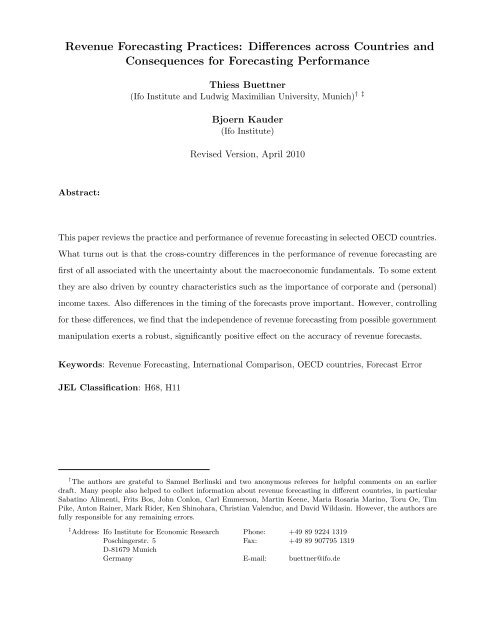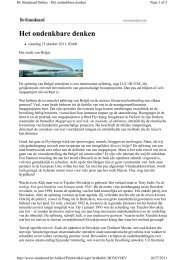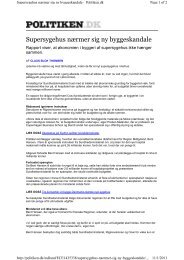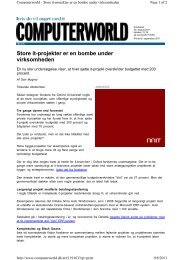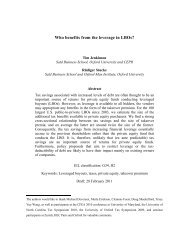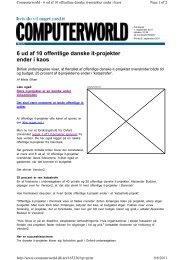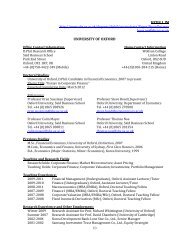Revenue Forecasting Practices: Differences across Countries and ...
Revenue Forecasting Practices: Differences across Countries and ...
Revenue Forecasting Practices: Differences across Countries and ...
You also want an ePaper? Increase the reach of your titles
YUMPU automatically turns print PDFs into web optimized ePapers that Google loves.
<strong>Revenue</strong> <strong>Forecasting</strong> <strong>Practices</strong>: <strong>Differences</strong> <strong>across</strong> <strong>Countries</strong> <strong>and</strong><br />
Consequences for <strong>Forecasting</strong> Performance<br />
Abstract:<br />
Thiess Buettner<br />
† ‡<br />
(Ifo Institute <strong>and</strong> Ludwig Maximilian University, Munich)<br />
Bjoern Kauder<br />
(Ifo Institute)<br />
Revised Version, April 2010<br />
This paper reviews the practice <strong>and</strong> performance of revenue forecasting in selected OECD countries.<br />
What turns out is that the cross-country differences in the performance of revenue forecasting are<br />
first of all associated with the uncertainty about the macroeconomic fundamentals. To some extent<br />
they are also driven by country characteristics such as the importance of corporate <strong>and</strong> (personal)<br />
income taxes. Also differences in the timing of the forecasts prove important. However, controlling<br />
for these differences, we find that the independence of revenue forecasting from possible government<br />
manipulation exerts a robust, significantly positive effect on the accuracy of revenue forecasts.<br />
Keywords: <strong>Revenue</strong> <strong>Forecasting</strong>, International Comparison, OECD countries, Forecast Error<br />
JEL Classification: H68, H11<br />
† The authors are grateful to Samuel Berlinski <strong>and</strong> two anonymous referees for helpful comments on an earlier<br />
draft. Many people also helped to collect information about revenue forecasting in different countries, in particular<br />
Sabatino Alimenti, Frits Bos, John Conlon, Carl Emmerson, Martin Keene, Maria Rosaria Marino, Toru Oe, Tim<br />
Pike, Anton Rainer, Mark Rider, Ken Shinohara, Christian Valenduc, <strong>and</strong> David Wildasin. However, the authors are<br />
fully responsible for any remaining errors.<br />
‡ Address: Ifo Institute for Economic Research<br />
Poschingerstr. 5<br />
D-81679 Munich<br />
Germany<br />
Phone:<br />
Fax:<br />
E-mail:<br />
+49 89 9224 1319<br />
+49 89 907795 1319<br />
buettner@ifo.de
1 Introduction<br />
When the financial crisis hit the economy of OECD countries in 2008 the fiscal outlook for most<br />
OECD countries deteriorated substantially. On the revenue side, tax receipts turned out to be<br />
much lower than officially predicted. In the US, for instance, the 2008 federal government revenues<br />
turned out to be 7.8 <strong>and</strong> 5.5 % below official revenue forecasts by the Congressional Budget Office<br />
from January 2007 <strong>and</strong> the Office of Management <strong>and</strong> Budget from February 2007. For Irel<strong>and</strong>, the<br />
2008 revenue figure issued by the Department of Finance in June 2007 turned out be 15.4 % lower<br />
than was predicted a year earlier. It seems straightforward to relate these forecast errors to the<br />
severe recession that hardly anyone predicted in the first half of 2007 when these forecasts had been<br />
made. However, given that these forecasts play an important role in setting up the budget, it seems<br />
interesting to compare the forecasting performance <strong>across</strong> countries <strong>and</strong> to discuss its relationship<br />
with different forecasting practices.<br />
Since revenue forecasting is an essential part of budgeting in the public sector, all countries make<br />
efforts to obtain reliable figures for the expected revenues – which is a difficult task. Preparing<br />
revenue forecasts involves not only predictions about the macroeconomic development but also<br />
predictions about the functioning of the tax law <strong>and</strong> its enforcement. Furthermore, there are<br />
changes in tax laws <strong>and</strong> structural changes in the economy that make forecasting even more difficult.<br />
Another possible uncertainty lies in repercussions of the revenue developments on public spending<br />
<strong>and</strong> the associated macroeconomic consequences. While these challenges are faced by forecasters<br />
in all countries, there are significant differences in the practice of revenue forecasting.<br />
In particular, institutional aspects of revenue forecasting differ. In several countries the executive<br />
1
anch of the government is directly in charge, other countries delegate the forecasting task to<br />
independent research institutes <strong>and</strong> emphasize the independence of forecasting. This raises the<br />
question of whether the forecasting performance is affected by the different practices involved.<br />
Given the efforts that some countries devote to ensuring independence from possible government<br />
manipulation, it is particularly interesting to explore whether this independence has a noticeable<br />
impact on the quality of the forecasts.<br />
The performance of revenue forecasting <strong>and</strong> possible determinants including institutional aspects<br />
have been explored in the literature in different directions (for a recent survey see Leal, Perez,<br />
Tujula, <strong>and</strong> Vidal, 2008). <strong>Revenue</strong> forecasting has received most attention in the context of US<br />
states’ revenue forecasts. Feenberg, Gentry, Gilroy, <strong>and</strong> Rosen (1989), for instance, provide evidence<br />
that state revenue forecasts are biased downwards. More recently, Boylan (2008) finds evidence<br />
for biases associated with the electoral cycle. Bretschneider, Gorr, Grizzle, <strong>and</strong> Klay (1989) focus<br />
on the accuracy of revenue forecasts <strong>and</strong> find that accuracy is higher in US states with competing<br />
forecasts from executive <strong>and</strong> legislative branches. Moreover, Krause, Lewis, <strong>and</strong> Douglas (2006)<br />
provide some evidence that the accuracy of states’ revenue fund estimates depend systematically<br />
on the staffing of the revenue forecasting teams. As Bretschneider et al. (1989) note, the design<br />
of US state governments has specific features such as balanced–budget rules <strong>and</strong> a rivalry between<br />
executive <strong>and</strong> legislative branches of government which may explain some of these results.<br />
International comparisons have mainly centered around forecasts of the budget balance. Recently,<br />
the relative performance of deficit forecasts among the European countries has been examined in the<br />
context of the European Union’s Stability <strong>and</strong> Growth Pact. Strauch et al. (2004) consider forecast<br />
errors associated with the so called “stability programmes” of EU member states, Jonung <strong>and</strong><br />
2
Larch (2006) discuss political biases of the output forecasts, Pina <strong>and</strong> Vedes (2007) are concerned<br />
with institutional <strong>and</strong> political determinants of forecast errors of budget balance. With regard<br />
to the more narrow issue of revenue forecasting, international comparisons of the practice <strong>and</strong><br />
performance are mainly concerned with developing countries (e.g., Kyobe <strong>and</strong> Danninger, 2005),<br />
where institutions relevant for revenue forecasting are underdeveloped (Danninger, 2005).<br />
Against this background this paper provides an analysis of the performance of official revenue fore-<br />
casts <strong>and</strong> its determinants among twelve OECD countries. The selection of countries aims at cap-<br />
turing the seven largest OECD economies (United States, Japan, Germany, Italy, UK, France, <strong>and</strong><br />
Canada). Some further countries were added where detailed information about revenue forecast-<br />
ing was available. This includes selected countries in Western Europe (Austria, Belgium, Irel<strong>and</strong>,<br />
Netherl<strong>and</strong>s) <strong>and</strong> New Zeal<strong>and</strong>.<br />
What turns out is that the cross-country differences in the performance of revenue forecasting<br />
are first of all associated with the uncertainty about the macroeconomic fundamentals. To some<br />
extent they are also driven by country characteristics such as the importance of corporate <strong>and</strong><br />
(personal) income taxes. Also differences in the timing of the forecasts prove important. However,<br />
controlling for these differences we find that the accuracy of revenue forecasting increases with the<br />
independence of forecasts from possible government manipulation.<br />
The following section presents descriptive statistics on the performance of revenue forecasting among<br />
our sample of OECD countries. Section 3 provides an overview on the different conditions that<br />
forecasters face in these countries. Section 4 discusses institutional aspects of the forecasting task<br />
among the selected OECD countries <strong>and</strong> sets up a simple indicator of the independence of revenue<br />
3
forecasting from possible government manipulation. Section 5 presents empirical evidence on the<br />
determinants of forecasting performance. Section 6 provides a short summary.<br />
2 <strong>Forecasting</strong> Performance<br />
A common way to assess the quality of revenue forecasts is to consider the forecast error defined<br />
as the percentage difference between forecasted <strong>and</strong> realized revenues. A smaller forecast error is<br />
then usually regarded as a better forecast quality. However, it should be noted that official revenue<br />
forecasts are basically used to indicate the revenue constraint that needs to be taken into account<br />
in the preparation of the public budget. Often, the budget will include expenditures that have a<br />
direct or indirect effect on tax revenues. While foreseeing these effects might result in a smaller<br />
forecast error, it is not clear whether this constitutes an improvement of a forecast that basically<br />
aims at providing the policy maker with information about the revenue constraint before actions<br />
are taken. In the discussion of the revisions of US revenue forecasts, therefore, policy changes are<br />
distinguished from (macro-)economic <strong>and</strong> so-called technical sources (Auerbach, 1999) of forecast<br />
errors, where the latter may refer to tax administration or evasion, for instance. However, for most<br />
countries a decomposition is not available. Therefore, the quantitative analysis presented below is<br />
based on the overall forecast error associated with the revenue forecast.<br />
We focus on the official tax-revenue forecasts used for setting up the budgets, i.e. we deal with<br />
revenue forecasts for the next fiscal year. In most cases this implies that we consider a one-year-<br />
ahead forecast error for tax revenues. In some cases, in particular, if the fiscal year differs from<br />
the calendar year, the forecast is sometimes issued in the same year where the fiscal year begins.<br />
4
Figure 1: Forecast Errors by Country/Institution<br />
CBO: US Congressional Budget Office, J: Japan, OMB: US Office of Management <strong>and</strong> Budget, IRL: Irel<strong>and</strong>,<br />
NL: Netherl<strong>and</strong>s, D: Germany, CDN: Canada, I: Italy, NZ: New Zeal<strong>and</strong>, B: Belgium, F: France, A: Austria,<br />
UK: United Kingdom.<br />
The figure displays the forecast errors for total tax revenues in percentage for up to thirteen years in each<br />
country, each point representing one forecast. Forecast errors for 2008 are highlighted. A positive (negative)<br />
value denotes overestimation (underestimation). The forecasts are arranged in descending order of the st<strong>and</strong>ard<br />
deviation of the respective forecast errors. The two US forecasts only refer to federal taxes.<br />
5
Figure 2: Forecast Errors by Year<br />
The figure displays the forecast errors for total tax revenues in percentage for 13 forecasts for revenues in 12<br />
countries. A positive (negative) value denotes overestimation (underestimation). The year at the horizontal<br />
axis refers to the year where the forecast has been issued.<br />
6
Since, ultimately, the forecast should indicate the revenue constraint to the current budget, we<br />
define forecast errors as the deviation of the forecasts from the final revenues reported for the<br />
corresponding fiscal year. 1 With regard to the time period covered, note that we include forecasts<br />
issued from 1995 until 2009 (see Table A.1 for an overview of the actual forecasts used), but for<br />
several countries revenue forecasts were not available for some years <strong>and</strong> most forecasts have been<br />
issued in the period from 1996 until 2007. 2 The forecast errors are depicted in Figures 1 <strong>and</strong> 2,<br />
where each point represents a single forecast error. Note that in Figure 1 the forecast errors are<br />
arranged in descending order of the respective st<strong>and</strong>ard deviation; in Figure 2 they are arranged<br />
according to the year in which the forecasts have been issued.<br />
At first sight, Figure 1 seems to suggest that in most cases there is some underestimation going on.<br />
But there are also instances of large overestimations. For instance, the US Congressional Budget<br />
Office issued a revenue forecast in January 2001 for the 2001-2002 fiscal year, which started October<br />
1, 2001, amounting to USD 2,236 Billion. Two years later revenues turned out to be only USD 1,853<br />
Billion. Hence the forecast has been about 20.6% higher than realized revenues. A revenue forecast<br />
by the Japanese Ministry of Finance from December 2007 for the fiscal year 2008-2009 turned out<br />
to overestimate actual revenues by as much as 21.0%. While also several other forecasts associated<br />
with 2008 (marked with a rhomb) turned out to be overoptimistic, errors of this magnitude are<br />
rare. According to Figure 2, the forecast errors show a marked cyclical pattern.<br />
Table 1 provides figures for the mean forecast error. A positive sign indicates an overestimation<br />
of revenues, a negative sign an underestimation. In all cases, except for Germany, Japan, <strong>and</strong><br />
1 Only for the most recent Canadian forecast, final revenues were not available.<br />
2 In the case of the Netherl<strong>and</strong>s due to structural breaks just five years are considered.<br />
7
Table 1: Descriptive Statistics of Forecast Errors<br />
Country MNFE SDFE RMSFE Obs. (Fiscal-) Years<br />
(1) (2) (3) (4) (5)<br />
Austria -0.037 2.279 2.162 10 1997-2006<br />
Belgium -0.432 2.611 2.545 13 1996-2008<br />
Canada -2.711 5.044 5.553 13 1997/98-2009/10<br />
France -1.151 2.542 2.672 10 1999-2008<br />
Germany 1.308 5.419 5.351 12 1997-2008<br />
Irel<strong>and</strong> -0.536 7.608 7.274 11 1998-2008<br />
Italy -2.297 4.626 4.973 11 1998-2008<br />
Japan 2.578 10.003 9.918 12 1997/98-2008/09<br />
Netherl<strong>and</strong>s -3.403 6.203 6.509 5 2000-2002, 2005-2006<br />
New Zeal<strong>and</strong> -1.535 3.939 4.058 11 1997/98-2007/08<br />
United Kingdom -0.213 1.977 1.897 11 1997/98-2007/08<br />
USA: CBO 0.807 10.175 9.775 12 1996/97-2007/08<br />
USA: OMB -0.472 9.031 8.659 12 1996/97-2007/08<br />
Average -0.623 5.497 5.488 11<br />
The first column shows the mean (MNFE) of the one-year-ahead forecast error for total revenues in<br />
percentage. A positive (negative) value denotes overestimation (underestimation). The second column<br />
depicts the st<strong>and</strong>ard deviation of the forecast error (SDFE) <strong>and</strong> the third column reports the root mean<br />
squared forecast error (RMSFE). The fourth column reports the number of observations <strong>and</strong> the last<br />
column depicts the time period considered.<br />
the CBO forecast in the United States, there is a slight underestimation of revenues. The largest<br />
difference from zero is found for the Netherl<strong>and</strong>s which shows an underestimation of 3.4 % on<br />
average. However, given the large st<strong>and</strong>ard deviations, statistically, the means are not significantly<br />
different from zero.<br />
The large differences in the st<strong>and</strong>ard deviation of the forecast errors (SDFE) point at substantial<br />
differences in the precision of forecasts. As can be seen in Column (2) of Table 1 the highest<br />
precision is achieved in the United Kingdom <strong>and</strong> Austria, while we find the lowest precision in the<br />
United States <strong>and</strong> Japan.<br />
8
Table 1 also reports the root mean squared forecast error (RMSFE) which is a common summary<br />
measure of forecasting accuracy, based on a quadratic loss function regarding forecast errors (e.g.,<br />
Clements <strong>and</strong> Hendry, 2002, <strong>and</strong> Wallis, 2008). Note that the RMSFE is equivalent to a combi-<br />
nation of the st<strong>and</strong>ard deviation of the forecast error <strong>and</strong> the mean forecast error. 3 However, as<br />
documented by Table 1, the st<strong>and</strong>ard deviation of the forecast error <strong>and</strong> the RMSFE of revenue<br />
forecasts do not show large differences.<br />
3 Conditions Faced by Forecasters<br />
An assessment of the considerable differences in the accuracy of forecasts needs to take account of<br />
the different conditions faced by the forecaster. First of all this is an issue of the point of time when<br />
the forecast is made. Across countries there are important differences in the time span between<br />
the official forecast <strong>and</strong> the beginning of the forecasted period, i.e. the beginning of the forecasted<br />
fiscal year (see Column (1) of Table 2). Actually, the median varies between less than one <strong>and</strong> 9.5<br />
months.<br />
An important source of differences lies in the tax structure of the countries. In particular, the degree<br />
of differentiation of the tax system might matter. Rather than relying on few large taxes a country<br />
might employ a variety of smaller tax instruments. Provided that the different tax instruments<br />
3 The mean squared forecast error (MSFE) can be decomposed into the squared mean of the forecast error (MNFE)<br />
<strong>and</strong> the squared st<strong>and</strong>ard deviation of the forecast error (SDFE) (e.g., Clements <strong>and</strong> Hendry, 1998). Formally, ignoring<br />
adjustments for the degrees of freedom, we have<br />
MSF �E<br />
� MNF �E<br />
2<br />
+ SDF �E<br />
2<br />
.<br />
Taking the square root yields the root mean squared forecast error RMSF E ≡ √ MSF E .<br />
9
Table 2: <strong>Forecasting</strong> Conditions<br />
Country Time Span Taxes for GDP Forecast error<br />
(Median) 50% rev. MNFE SDFE RMSFE<br />
(1) (2) (3) (4) (5)<br />
Austria 3.5 71.1 -0.209 1.134 1.096<br />
Belgium 2.5 53.4 0.072 1.249 1.202<br />
Canada 1.5 34.3 0.114 1.837 1.768<br />
France 3.5 103.3 0.185 0.910 0.883<br />
Germany 7.5 38.3 0.284 0.987 0.987<br />
Irel<strong>and</strong> 0.5 20.3 -0.387 2.628 2.536<br />
Italy 5.5 48.1 0.518 1.122 1.189<br />
Japan 3.5 36.0 0.393 1.688 1.664<br />
Netherl<strong>and</strong>s 9.5 41.1 0.252 1.605 1.458<br />
New Zeal<strong>and</strong> 1.5 19.6 -0.334 1.757 1.708<br />
United Kingdom 0.5 41.4 -0.544 0.915 1.028<br />
US: CBO<br />
US: OMB<br />
8.5<br />
8<br />
22.0 -0.280 1.365 1.336<br />
Average 4.1 42.1 0.005 1.428 1.399<br />
The time span in the first column measures the median time-period between the forecast <strong>and</strong> the beginning<br />
of the forecasted period in months. It is taken from the various national sources listed in the appendix. In<br />
the second column the number of taxes needed to account for 50% of revenues in the respective country is<br />
shown based on the OECD <strong>Revenue</strong> Statistics.<br />
10
elate to tax bases that are not closely correlated, this might reduce the revenue risks associated<br />
with the tax system. Therefore, forecasting the revenues of a large variety of small taxes might be<br />
easier than predicting the revenues in a system that relies on a small number of large taxes. To<br />
capture the differentiation of the tax structure we use an indicator of the number of taxes based<br />
on the OECD <strong>Revenue</strong> Statistics. More specifically, we employ the most detailed classification<br />
of taxes <strong>and</strong>, starting with the smallest taxes, count the number of taxes needed to account for<br />
50% of all tax revenues. 4 Of course this measure is only informative if the individual taxes are<br />
really different in the above sense. Moreover, comparing the number of taxes <strong>across</strong> countries raises<br />
difficult problems of classifying taxes <strong>and</strong> the OECD classification meets the various tax systems<br />
to a different extent. Nevertheless, relying on this classification, Column (2) indicates that there<br />
are large differences <strong>across</strong> countries.<br />
Some types of taxes might be more difficult to predict than others. For instance, we might expect<br />
that there are significant differences in the forecast accuracy when forecasting corporation or per-<br />
sonal income taxes as compared to sales <strong>and</strong> value added taxes. This calls for a separate analysis of<br />
forecast errors according to the type of tax. The empirical analysis below, therefore, distinguishes<br />
four groups of taxes: personal income, corporation, value added <strong>and</strong> sales, as well as other taxes.<br />
This decomposition is also useful since the revenue forecasts are usually prepared for aggregates of<br />
individual taxes especially if these taxes share the same source or tax payer. This partly reflects the<br />
need to employ up-to-date information on current revenues, which is available usually on a source<br />
basis.<br />
4 While this measure is concerned with the 50% percentile, note that the results are found to be robust against<br />
choosing different percentiles.<br />
11
Another potentially important reason for differences in the forecast errors is related to the un-<br />
certainty about the business cycle <strong>and</strong> the macroeconomic development. This uncertainty is of<br />
particular importance not only because almost all taxes are affected by the macroeconomic en-<br />
vironment. A typical feature of revenue forecasting is that taxes which are strongly driven by<br />
macroeconomic developments such as corporation taxes or wage <strong>and</strong> income taxes are forecasted<br />
with indirect methods. Predominantly, the elasticity method is employed where some previously<br />
estimated elasticity is used to predict revenue growth based on the predicted development of the<br />
GDP or its components. 5<br />
Columns (3) to (5) of Table 2 provide some statistics for the macroeconomic uncertainty for each of<br />
the different countries. Note that as with the revenue forecast we are relying on the relative forecast<br />
error in percentage points. For instance, the mean forecast error of -0.544 for the UK indicates that<br />
on average predicted GDP was about half percentage point lower than actual GDP. 6 Note that the<br />
GDP forecasts are not taken from the same source as the above official revenue forecasts. This is<br />
important since in some cases the macroeconomic predictions used by the forecasters are based on<br />
their own assessment, in other cases the macroeconomic forecasts of the government are used (see<br />
below). Conditioning on these predictions would not allow us to capture the impact of possible<br />
government manipulation. Therefore, we resort to the German council of economic experts, an<br />
independent body which annually issues forecasts of the macroeconomic developments including<br />
GDP for a large group of countries. 7<br />
5 For an overview of methods of revenue forecasting, see King (1993).<br />
6 As in the case of revenue forecasts, the forecast error is computed relative to final figures.<br />
7 An advantage of these forecasts is that the one-year ahead forecasts are issued every year in November such that<br />
there are no timing differences <strong>across</strong> countries <strong>and</strong> time.<br />
12
Uncertainty about revenues also stems from changes in the tax law. Already the immediate “me-<br />
chanical” effects of tax law changes are often difficult to estimate. In addition, changes in the tax<br />
law exert all sorts of behavioral effects with revenue consequences that are hard to quantify. 8 This<br />
implies that revenue forecasts tend to be much more difficult in the presence of tax-law changes.<br />
While this may suggest to somehow capture revenue effects of major tax reforms, we have not<br />
been able to collect data on revenue estimates for tax reforms. But, we should note that there<br />
is also uncertainty about which tax law changes will actually be implemented. In some countries,<br />
it is common practice not only to include in the revenue forecasts those tax law changes that<br />
are already enacted but also to include changes that are agreed within the government (Austria,<br />
Netherl<strong>and</strong>s) or noted in the budget plan (Irel<strong>and</strong>). If these changes are postponed, amended, or<br />
withdrawn, large forecast errors may occur even if the revenue estimate of the reform which was<br />
initially intended was correct.<br />
4 Institutions <strong>and</strong> Independence<br />
A basic institutional aspect of revenue forecasting is the assignment of the forecasting task to<br />
specific institutions. Interestingly, forecasting is not always assigned to a department of the gov-<br />
ernment or, more precisely, to the executive branch of the government. Only in about half of<br />
the thirteen forecasts surveyed in this paper it is the Ministry of Finance (Belgium, France, Italy,<br />
Irel<strong>and</strong>, Japan) or the Treasury (United Kingdom, New Zeal<strong>and</strong>) that is responsible. 9 In most<br />
other cases forecasting is assigned to a group representing different institutions, not only from the<br />
8 For a discussion of “dynamic scoring” in revenue estimation see Adam <strong>and</strong> Bozio (2009) <strong>and</strong> Auerbach (2005).<br />
9 For a detailed list of sources for the various forecasts covered see Appendix.<br />
13
executive branch. Some countries even assign the primary responsibility for revenue forecasting to<br />
independent research institutes (Netherl<strong>and</strong>s) <strong>and</strong> limit the influence of the executive branch to<br />
merely consult forecasters. In the other countries, even if the Ministry of Finance or another part<br />
of the executive is responsible, often external experts from academia or forecasting agencies are<br />
included in the forecasting group.<br />
The efforts to involve institutions that are not part of the government or external experts are<br />
usually justified as a means to raise the independence of revenue forecasting from possible manip-<br />
ulation <strong>and</strong> strategic influences by the government. Several countries explicitly produce consensus<br />
forecasts, where all institutions <strong>and</strong> experts involved have to agree on the forecast (e.g., Germany<br />
<strong>and</strong> Austria). However, the extent to which forecasting is independent from government manipula-<br />
tion is not only depending on the assignment of the forecasting responsibility but also on whether<br />
revenue forecasting is based on government predictions for the macroeconomic development, as is<br />
the case with the official German forecast.<br />
Table 3 presents information about how revenue forecasting differs with respect to these issues. The<br />
first column indicates whether the government (=0), research institutes (=1) or both jointly (=0.5)<br />
are responsible for the forecast. In some cases there are no research institutes involved, but in order<br />
to preserve a certain degree of independence there are external experts consulted (see Column (2)).<br />
This is the case for the US forecasts of the Congressional Budget Office (CBO) <strong>and</strong> the Office of<br />
Management <strong>and</strong> Budget (OMB). In the case of the United Kingdom a value of 0.5 is entered, in<br />
order to take account of the reported partial consultation of experts. Also for Germany a figure<br />
of 0.5 is entered in order to account for the additional participation of the German central bank.<br />
For the Netherl<strong>and</strong>s a figure of -1 is entered to take account of the consulting participation of the<br />
14
ministry of finance that may tend to reduce independence. The third column provides information<br />
about the source of the macroeconomic forecast. A value of one indicates that an external forecast<br />
is used.<br />
By summing <strong>across</strong> the first three columns we obtain a simple indicator of the independence of<br />
revenue forecasting. The first column is weighted with unity, the second <strong>and</strong> the third columns are<br />
weighted with 0.25. The rationale behind this weighting is the following: a revenue forecast that<br />
is conducted by a research institute without any government experts involved would display the<br />
maximum level of independence (=1). A government forecast that includes external experts <strong>and</strong><br />
employs an external macroeconomic forecast would obtain a medium level of independence (=0.5).<br />
A government forecast without any external experts <strong>and</strong> without an external macroeconomic fore-<br />
cast would be assigned the lowest level of independence (=0).<br />
While the indicator varies from zero (=no independence) to unity (=full independence), in our<br />
sample of countries the highest degree of independence is 0.75. As can be seen, the indicator<br />
is highest for the Netherl<strong>and</strong>s <strong>and</strong> Austria, followed by Germany. A small, but positive level of<br />
independence can be found in Canada, New Zeal<strong>and</strong>, Belgium <strong>and</strong> the United Kingdom. The United<br />
States case is somewhat special since here two separate forecasts exist. One is conducted by the<br />
Office of Management <strong>and</strong> Budget (OMB) that assists the executive branch, the other is conducted<br />
by the Congressional Budget Office (CBO) that is assigned to the legislative branch. While their<br />
incentives to manipulate forecasts strategically might differ, our indicator of independence, which is<br />
simply assessing the institutional conditions, assigns a low value of independence to both of them. 10<br />
10 Bretschneider et al. (1989) argue that the existence of two separate forecasts by the legislative <strong>and</strong> the executive<br />
branch exerts a positive effect on forecasting accuracy, in particular, when both forecasts are forced into a consensus.<br />
This is, however, not the case with the OMB <strong>and</strong> CBO.<br />
15
Table 3: Institutional Characteristics <strong>and</strong> Independence<br />
Research Ext./Gov. Macroecon. Indepen-<br />
Country institutes experts forecast dence<br />
Netherl<strong>and</strong>s 1 -1 0 0.75<br />
Austria .5 0 1 0.75<br />
Germany .5 .5 0 0.625<br />
USA: OMB 0 1 0 0.25<br />
USA: CBO 0 1 0 0.25<br />
Canada 0 0 1 0.25<br />
New Zeal<strong>and</strong> 0 1 0 0.25<br />
Belgium 0 0 1 0.25<br />
United Kingdom 0 .5 0 0.125<br />
Japan 0 0 0 0.00<br />
France 0 0 0 0.00<br />
Italy 0 0 0 0.00<br />
Irel<strong>and</strong> 0 0 0 0.00<br />
First column indicates whether the government (= 0), research institutes (= 1) or both jointly are responsi-<br />
ble for the forecast (= 0.5). Second column indicates whether external (= 1) or government experts (= −1)<br />
are involved. For the United Kingdom a value of 0.5 is entered, in order to take account of the reported<br />
partial consultation of experts. In Germany a figure 0.5 is entered in order to account for the participation<br />
of the central bank. Third column provides information about whether an external macroeconomic forecast<br />
is used (the appendix provides a list of various national sources providing this information). The degree<br />
of independence in the last column is obtained as a weighted sum of the first three columns. The first<br />
column is weighted with unity, the second <strong>and</strong> the third columns are weighted with 0.25 (see text).<br />
The general composition of the index with its emphasis on research institutes, external experts,<br />
<strong>and</strong> the source of the macroeconomic forecast reflects key institutional characteristics of revenue<br />
forecasting. Yet the weights, used to aggregate the information about these institutional aspects,<br />
are somewhat arbitrary. Therefore, we conducted some robustness checks where the weights for<br />
external experts <strong>and</strong> external macroeconomic forecasts were increased or lowered. With regard to<br />
the ranking, however, only minor changes were found. We will come back to this issue below, where<br />
we explore whether the index of independence has sufficient informational content in order to help<br />
explaining the observed forecasting performance.<br />
16
Though we include several European countries, the index does not take account of the fiscal surveil-<br />
lance by the European Union institutions. Since 1999 due to the Stability <strong>and</strong> Growth Pact (SGP),<br />
EU member states are required to submit budgetary projections including revenue forecasts every<br />
year to the European Commission <strong>and</strong> the Ecofin Council. The forecasts also play a role in the<br />
Excessive Deficit Procedure, which defines sanctions for member states that continuously violate<br />
the agreed fiscal rules. It should be noted, however, that the purpose of corresponding revenue<br />
forecasts is different: they are not issued to set up <strong>and</strong> justify the budget plan. Rather these pro-<br />
jections provide the European Commission <strong>and</strong> the Ecofin Council with necessary information for<br />
purposes of surveillance of budgetary positions <strong>and</strong> economic policies. Nevertheless, the existence<br />
of a supra-national body discussing <strong>and</strong> st<strong>and</strong>ardizing revenue forecasts of the member states might<br />
well have implications for the national governments’ revenue forecasts. By including indicators for<br />
EU countries in the time period starting in 1999, the empirical analysis below tests for a possible<br />
impact on the performance of revenue forecasts.<br />
5 Determinants of <strong>Forecasting</strong> Performance<br />
Having outlined differences in the forecasting conditions <strong>and</strong> practices let us finally turn to the<br />
question as to what extent these are associated with the large differences in forecasting performance<br />
noted above. In a first step we consider the level of the revenue forecast error <strong>and</strong> test for the<br />
presence of forecast biases. Table 4 provides the results.<br />
Column (1) indicates that the overall mean or average forecast error is not significantly different<br />
from zero. The specification in Column (2) takes account of the panel structure of the data <strong>and</strong><br />
17
Table 4: Determinants of Forecast Error<br />
(1) (2) (3) (4) (5) (6)<br />
Constant -.486 -.441 .171 2.65<br />
(.517) (.463) (4.02) (3.62)<br />
GDP forecast error 1.89 ⋆⋆ 1.99 ⋆⋆ 1.92 ⋆⋆<br />
(.316) (.323) (.322)<br />
Time span .091 .000<br />
(.167) (.150)<br />
log No. of taxes -.166 -.879<br />
for 50% of revenue (1.12) (1.01)<br />
Independence -.308 .326<br />
(2.29) (2.06)<br />
Germany 1.31 .743<br />
(1.81) (1.60)<br />
Austria -.037 .380<br />
(1.98) (1.75)<br />
Netherl<strong>and</strong>s -3.40 -3.90<br />
(2.80) (2.47)<br />
Belgium -.432 -.576<br />
(1.73) (1.53)<br />
France -1.15 -1.52<br />
(1.98) (1.75)<br />
Italy -2.30 -3.33 ⋆⋆<br />
(1.88) (1.67)<br />
United Kingdom -.213 .869<br />
(1.88) (1.67)<br />
Irel<strong>and</strong> -.536 .234<br />
(1.88) (1.67)<br />
USA-CBO .807 1.36<br />
(1.80) (1.60)<br />
USA-OMB -.472 0.84<br />
(1.80) (1.60)<br />
Canada -2.71 -2.94 ⋆<br />
(1.73) (1.53)<br />
New Zeal<strong>and</strong> -1.54 -.871<br />
(1.88) (1.67)<br />
Japan 2.58 1.80<br />
(1.80) (1.60)<br />
R 2 0.000 0.067 0.202 0.279 0.003 0.207<br />
Observations 143 143 143 143 143 143<br />
Dependent variable: One-year-ahead forecast error for total tax revenues. St<strong>and</strong>ard errors in parentheses.<br />
One star denotes significance at the 10 % level, two stars at 5% level.<br />
18
allows for institution specific differences in a potential bias, which prove insignificant, however. To<br />
take account of the difficulties in predicting the macroeconomic environment, Columns (3) <strong>and</strong> (4)<br />
condition on the one-year ahead GDP forecast error for each country. It shows a strongly significant<br />
impact indicating that an unpredicted increase in GDP by 1% results in an increase of revenues by<br />
almost 2%. According to Column (3) the average conditional forecast is not significantly different<br />
from zero. When we allow the average forecast error to differ between forecasting institutions (see<br />
Column (4)), we find that only the forecasts for Italy <strong>and</strong> Canada show significant biases. In both<br />
cases, conditional on the forecast error associated with the GDP forecast, the estimation indicates<br />
that, on average, forecasts have been too pessimistic.<br />
In order to explore whether differences in the forecast errors can be assigned to the forecasting<br />
institutions, in Columns (5) <strong>and</strong> (6) we replace the dummies with a set of institution specific<br />
indicators most of which are time-invariant. The set of indicators includes the time-span between<br />
the forecast <strong>and</strong> the forecasted period, the indicator of the differentiation of the tax structure, as well<br />
as the indicator of the independence of forecasting institutions. However, all these indicators are not<br />
significant. While not shown, note that we also tested for some specific effect for European countries,<br />
which are required from 1999 onwards to report revenue forecasts to European institutions. Even if<br />
we allow the coefficients for the European countries to differ in the time period from 1999 onwards,<br />
no significant differences are found.<br />
The failure to find significant effects of institutional characteristics <strong>and</strong> country characteristics on<br />
the mean forecast error does not necessarily indicate that they do not exert any effect on revenue<br />
forecasts. Certainly, in the process of setting up the budget, a government or parliament is tempted<br />
to manipulate revenue forecast, <strong>and</strong> to underestimate or overestimate revenues. Yet a sustained<br />
19
manipulation in one direction, which would show up in a significant bias of the forecasts, hardly<br />
affects rational agents’ beliefs <strong>and</strong> merely undermines the credibility of the official forecast. 11<br />
In a second step of the analysis, we explore the differences in the forecasting performance using<br />
measures of forecast precision <strong>and</strong> accuracy. More precisely we consider the st<strong>and</strong>ard deviation<br />
of the forecast error (SDFE) which is an indicator of the precision of forecasts as well as the root<br />
mean squared forecast error (RMSFE) which is a common summary statistic of forecast accuracy.<br />
The first two specifications in Table 5 explore whether differences in forecasting conditions show<br />
some significant effects on the precision of the forecasts, measured by the st<strong>and</strong>ard deviation of<br />
the forecast error for total tax revenues. Column (1) just includes indicators of the macroeconomic<br />
uncertainty <strong>and</strong> of the time span between the forecast <strong>and</strong> the beginning of the forecasted period.<br />
The results confirm a strong impact of the macroeconomic uncertainty measured by the st<strong>and</strong>ard<br />
deviation of the GDP forecast error. They also indicate that the precision decreases considerably<br />
with the time span: every additional month increases the st<strong>and</strong>ard deviation by three quarters of<br />
a percentage point. In Column (2) we include the above indicator for the differentiation of the tax<br />
system into single taxes. The negative sign indicates that forecasting is more precise in countries<br />
where the number of taxes is large. However, the effect is not significant.<br />
Columns (3) <strong>and</strong> (4) show the same specifications augmented with the indicator of the independence<br />
of revenue forecasting. While the results from Columns (1) <strong>and</strong> (2) are confirmed, we find that the<br />
precision of the forecast is positively associated with the independence from possible government<br />
manipulation. The specification in Column (3) indicates that about 80% of the variation in the<br />
11 Consistent with this view, the literature developing models of rational forecast bias relies on settings not with<br />
one but with multiple forecasting agents, where individual forecasters have incentives to differentiate their forecasts<br />
from those of other forecasters (e.g., Laster, Bennet, <strong>and</strong> Sum, 1999).<br />
20
Table 5: Determinants of <strong>Forecasting</strong> Precision <strong>and</strong> Accuracy, Total <strong>Revenue</strong>s<br />
Dependent variable SDFE RMSFE<br />
(1) (2) (3) (4) (5) (6) (7) (8) (9) (10)<br />
Constant -.669 7.04 .892 7.16 .665 .905 2.74 3.66 2.22 -.372<br />
(1.78) (7.47) (1.67) (6.38) (1.56) (1.81) (1.68) (6.22) (1.53) (5.72)<br />
Time span .734 ⋆⋆ .635 ⋆⋆ .861 ⋆⋆ .773 ⋆⋆ .887 ⋆⋆ .830 ⋆⋆ .772 ⋆⋆ .762 ⋆⋆ .755 ⋆⋆ .785 ⋆⋆<br />
(.190) (.210) (.171) (.192) (.167) (.177) (.152) (.175) (.130) (.151)<br />
log No. of taxes -1.63 -1.34 -.216 .584<br />
for 50% of revenue (1.54) (1.32) (1.39) (1.24)<br />
Independencea -4.40 ⋆ -4.19 ⋆ -4.88 ⋆⋆ -3.61 ⋆ -3.89 ⋆ -3.88 ⋆ -3.44 ⋆⋆ -3.42 ⋆<br />
(2.00) (2.01) (2.00) (1.94) (1.72) (1.84) (1.47) (1.55)<br />
EU-SGP -2.15 ⋆ -2.05 -2.13 ⋆⋆ -2.39 ⋆<br />
(1.03) (1.27) (.873) (1.07)<br />
SDFE for GDP 4.36 ⋆⋆ 3.08 4.03 ⋆⋆ 3.00 ⋆ 4.08 ⋆⋆ 4.02 ⋆⋆ 3.34 ⋆⋆ 3.21 ⋆⋆<br />
(1.20) (1.69) (1.03) (1.44) (.984) (1.09) (.937) (1.32)<br />
RMSFE for GDP 3.66 ⋆⋆ 4.10 ⋆⋆<br />
(.878) (1.30)<br />
21<br />
R2 0.677 0.713 0.790 0.814 0.805 0.767 0.864 0.864 0.894 0.897<br />
R2 adjusted 0.612 0.617 0.720 0.721 0.741 0.689 0.796 0.767 0.841 0.824<br />
Observations 13 13 13 13 13 13 13 13 13 13<br />
Dependent variable in Columns (1)-(8) is the st<strong>and</strong>ard deviation of one-year-ahead forecast error (SDFE) for total tax revenues. Columns (9) <strong>and</strong> (10)<br />
focus on the root-mean-squared forecast error (RMSFE). Weighted least squares estimates taking account of the number of forecasts considered in the<br />
computation of the st<strong>and</strong>ard deviation. Robust st<strong>and</strong>ard errors in parentheses. One star denotes significance at the 10 % level, two stars at 5% level. a )<br />
Column (5) provides results from a specification where the index of independence uses a higher weight for external macroeconomic forecasts <strong>and</strong> external<br />
experts. Column (6) refers to a specification where the index uses a smaller weight for external macroeconomic forecasts <strong>and</strong> external experts.
precision of the forecasts can be associated with the time span, the macroeconomic uncertainty <strong>and</strong><br />
the degree of independence.<br />
Since the indicator of independence rests on a weighted sum of three institutional characteristics we<br />
conducted some robustness tests using different weights. However, the results do not indicate major<br />
differences. If the weights for external experts or external macroeconomic forecasts are increased<br />
or lowered by 0.1, for instance, all effects are confirmed (see Columns (5) <strong>and</strong> (6)).<br />
To capture separate fiscal forecasting requirements according to the Stability <strong>and</strong> Growth Pact,<br />
Columns (7) <strong>and</strong> (8) include an indicator for EU countries (EU-SGP). It captures the share of<br />
forecasts for European countries that were issued in the time period from 1999 onwards, when<br />
regular reports have to be filed for European institutions. Interestingly, it shows a significantly<br />
negative effect, suggesting that the precision of revenue forecasting has generally been increased in<br />
the presence of budgetary surveillance by the European Union. Yet a causal interpretation seems<br />
problematic, since the formation of the European monetary union might have exerted separate<br />
effects on the forecasting task.<br />
Columns (9) <strong>and</strong> (10) report results of specifications where we replace the st<strong>and</strong>ard deviation of the<br />
forecast error with the root mean squared forecast error - a common summary statistic for forecast<br />
accuracy. While the set of explanatory variables is the same as above, for reasons of consistency,<br />
macroeconomic uncertainty is also captured by the root mean squared error of the GDP forecast.<br />
It turns out that the results are very similar to the results in Columns (7) <strong>and</strong> (8). Since the root<br />
mean squared forecast error combines the st<strong>and</strong>ard deviation <strong>and</strong> the mean of the forecast error<br />
(see above), this similarity reflects the above finding that differences in the st<strong>and</strong>ard deviation of<br />
22
the forecast error are much more pronounced than differences in the means. 12<br />
Table 6 provides results for the precision of forecasts decomposed into four different types of taxes:<br />
(personal) income taxes, corporation taxes, sales taxes, <strong>and</strong> other taxes. Thus, for each group<br />
of taxes we compute separate indicators of forecast precision <strong>and</strong> forecast accuracy. 13 A first<br />
specification uses a similar set of variables as Column (3) of Table 5. In addition, it includes dummy<br />
variables for each group of taxes. The coefficients of these variables indicate that corporation taxes<br />
show a much larger st<strong>and</strong>ard deviation of the forecast error. As documented by the coefficient of<br />
determination in Column (1) about 86% of the differences in the precision of the forecasts can be<br />
assigned to tax structure, timing, <strong>and</strong> independence. In Column (2) the number of taxes needed<br />
to account for 50% of revenues is included. While it is insignificant, note that in the specifications<br />
reported in Table 6 this indicator refers to the corresponding group of taxes.<br />
To test whether the time-span has different effects <strong>across</strong> types of taxes, in Columns (3) <strong>and</strong> (4)<br />
we allow for possible differences in the effect of the timing among the different groups of taxes. As<br />
can be seen, the time span is relevant, particularly for corporation taxes, but also for income taxes.<br />
All specifications support a negative significant effect for the independence of revenue forecasts.<br />
Columns (5) <strong>and</strong> (6) include indicators for the share of forecasts where reporting requirements to<br />
EU institutions existed (EU-SGP). Again, we find significantly negative effects, suggesting that<br />
the quality of revenue forecasts is increased as a result. The final two columns report results of<br />
specifications that focus on the root mean squared forecast error. As above, the results are very<br />
similar, qualitatively.<br />
12 Note that also an analysis based on the mean absolute error yields qualitatively similar results.<br />
13 Missing values are encountered since detailed information was not available for all countries.<br />
23
Table 6: Determinants of <strong>Forecasting</strong> Precision <strong>and</strong> Accuracy, Disaggregated <strong>Revenue</strong>s<br />
Dependent variable SDFE RMSFE<br />
(1) (2) (3) (4) (5) (6) (7) (8)<br />
Time span .985 ⋆⋆ 1.08 ⋆⋆ -.014 .055 -.153 .015 -.172 .035<br />
(.130) (.243) (.284) (.351) (.345) (.382) (.338) (.367)<br />
Time span × Tax type 1 1.54 ⋆⋆ 1.45 ⋆⋆ 1.54 ⋆⋆ 1.28 ⋆⋆ 1.51 ⋆⋆ 1.21 ⋆⋆<br />
(.484) (.555) (.491) (.522) (.441) (.473)<br />
Time span × Tax type 2 1.95 ⋆⋆ 1.88 ⋆⋆ 1.95 ⋆⋆ 1.75 ⋆⋆ 1.83 ⋆⋆ 1.59 ⋆⋆<br />
(.730) (.765) (.742) (.729) (.733) (.707)<br />
Time span × Tax type 3 .512 .469 .512 .391 .604 ⋆ .462<br />
(.339) (.360) (.344) (.360) (.335) (.336)<br />
SDFE for GDP 3.68 ⋆⋆ 5.38 ⋆⋆ 3.68 ⋆⋆ 4.02 ⋆⋆ 3.01 ⋆⋆ 3.84 ⋆⋆<br />
(1.06) (1.82) (1.10) (1.25) (.610) (1.32)<br />
RMSFE for GDP 3.09 ⋆⋆ 4.23 ⋆⋆<br />
(.484) (1.31)<br />
log No. of taxes 2.09 .419 1.18 1.39<br />
for 50% of revenue (1.41) (.950) (1.10) (1.06)<br />
Independence -4.87 ⋆⋆ -4.89 ⋆ -4.87 ⋆ -4.87 ⋆ -3.57 ⋆⋆ -3.33 ⋆ -2.82 ⋆⋆ -2.46 ⋆<br />
(2.15) (2.60) (2.23) (2.32) (1.48) (1.58) (1.34) (1.34)<br />
EU-SGP -2.65 ⋆⋆ -3.17 ⋆⋆ -2.68 ⋆⋆ -3.25 ⋆⋆<br />
(.641) (.958) (.509) (.812)<br />
Tax type 1 (Income taxes) 2.45 -2.66 2.44 1.42 4.21 ⋆⋆ 1.67 4.00 ⋆⋆ .763<br />
(2.15) (3.87) (2.16) (2.63) (1.38) (3.38) (1.12) (3.24)<br />
Tax type 2 (Corporation taxes) 11.0 ⋆⋆ 6.13 11.0 ⋆⋆ 10.0 ⋆⋆ 12.7 ⋆⋆ 10.3 ⋆⋆ 12.5 ⋆⋆ 9.38 ⋆⋆<br />
(2.68) (3.43) (2.61) (2.50) (2.04) (3.19) (1.85) (3.11)<br />
Tax type 3 (Sales taxes) .782 -8.21 .788 -1.01 2.56 ⋆ -2.18 2.50 ⋆⋆ -3.32<br />
(2.07) (6.59) (2.08) (3.99) (1.20) (5.13) (.939) (5.04)<br />
Tax type 4 (Others) .868 -6.04 .880 -.504 2.65 ⋆⋆ -.911 2.41 ⋆⋆ -2.02<br />
(2.41) (5.50) (2.25) (3.30) (1.07) (3.98) (.933) (3.94)<br />
24<br />
R2 0.862 0.874 0.916 0.916 0.925 0.928 0.928 0.932<br />
Observations 48 48 48 48 48 48 48 48<br />
Dependent variable in Columns (1)-(6) is the st<strong>and</strong>ard deviation of one-year-ahead forecast error (SDFE) for tax revenues grouped into four types of<br />
taxes. Columns (7) <strong>and</strong> (8) focus on the root-mean-squared forecast error (RMSFE). Robust st<strong>and</strong>ard errors in parentheses take account of possible<br />
correlation between the forecasts for different groups of taxes. One star denotes significance at the 10 % level, two stars at 5% level.
6 Summary<br />
In this paper we have compared revenue forecasting practice <strong>and</strong> performance <strong>across</strong> selected OECD<br />
countries. While the mean forecast error is small in most countries, the st<strong>and</strong>ard deviation of the<br />
forecast error <strong>and</strong> also summary statistics of forecast accuracy such as the root mean squared<br />
forecast error point at substantial differences in the forecasting performance <strong>across</strong> countries. This<br />
raises the question of whether differences in the performance are associated with differences in the<br />
conditions <strong>and</strong> practices of revenue forecasting in these countries.<br />
First of all, it seems likely that important conditions for revenue forecasting are different. This refers<br />
to the uncertainty about the macroeconomic fundamentals as well as to country characteristics such<br />
as the tax structure both in terms of the differentiation into different taxes as well as with regard to<br />
the importance of corporate <strong>and</strong> (personal) income taxes. But also institutional arrangements vary<br />
between countries. This refers not only to the timing of revenue forecasts. While in some countries<br />
the ministry of finance or the treasury is responsible, other countries delegate the forecasting task<br />
to research institutes. Further differences arise with regard to the inclusion of external experts <strong>and</strong><br />
with regard to the source of macroeconomic forecasts. To summarize these differences we come<br />
up with an index of the independence from possible government manipulation. According to this<br />
index the revenue forecasts are most independent in the Netherl<strong>and</strong>s <strong>and</strong> in Austria.<br />
The quantitative analysis shows that the cross-country differences in the performance of revenue<br />
forecasting are first of all related to the uncertainty about the macroeconomic development: the<br />
GDP forecast error exerts a strong effect on the error of revenue forecasts <strong>and</strong> also the precision<br />
of the revenue forecasts, measured by the st<strong>and</strong>ard deviation of the forecast error, is found to be<br />
25
driven by macroeconomic uncertainty. Controlling also for differences in the timing of the forecasts,<br />
we find that the precision of revenue forecasts increases with the independence of forecasts from<br />
possible government manipulation. About 80% of the differences in forecasting precision concerning<br />
the total revenues can be explained by differences in macroeconomic uncertainty, in the timing, <strong>and</strong><br />
in the degree of independence. For the European countries we find some evidence that forecasting<br />
precision has increased with the establishment of fiscal surveillance by the European institutions.<br />
But, it seems difficult to interpret this finding as a causal effect, since the creation of the monetary<br />
union might also have exerted direct effects on the difficulties of the forecasting task.<br />
The results are confirmed when distinguishing between four groups of taxes, i.e. (personal) income<br />
taxes, corporation taxes, sales taxes, <strong>and</strong> a residual category. This analysis further shows that the<br />
forecasting precision is particularly low for income <strong>and</strong> corporation taxes. For these taxes we find<br />
that the precision depends strongly on the time-span between the forecast <strong>and</strong> the beginning of the<br />
forecasted period.<br />
Our finding of a significant impact of institutional conditions on forecasting performance proves<br />
robust against alternative measures of the forecasting accuracy. Employing the root mean squared<br />
forecast error as a summary measure of forecasting accuracy we obtain very similar results.<br />
While we have provided robust evidence for a beneficial effect of independence on forecast accuracy,<br />
an analysis of the incentives of governments to exert an influence on forecasts <strong>and</strong> the consequences<br />
of this influence is beyond the scope of the current paper <strong>and</strong> is left for future research. However,<br />
given the weak evidence for significant biases, our analysis suggests that government influence tends<br />
to show up in temporary deviations of forecasts from the expected values.<br />
26
Appendix: Sources of Information<br />
A.1 Austria<br />
The official revenue forecast for Austria is documented/discussed in:<br />
• Bundesministerium für Finanzen (2007): Budget 2007-2008, Zahlen – Hintergründe – Zusammenhänge.<br />
Online: www.bmf.gv.at<br />
• Homepage of the Ministry of Finance: www.bmf.gv.at<br />
• Homepage of the Wifo ( Österreichisches Institut für Wirtschaftsforschung): www.wifo.ac.at<br />
• Leibrecht (2004)<br />
A.2 Belgium<br />
The revenue forecast of the federal government is documented/discussed in:<br />
• Chambre des représentants de Belgique: Budgets des Recettes et des Dépenses pour l’année<br />
budgétaire 1996, ... pour l’année budgétaire 2007, Brussels<br />
• Hertveldt, Bart et al. (2003)<br />
• Lenoir, Thierry <strong>and</strong> Valenduc, Christian (2006): Révision de la méthode macro-économique<br />
d’estimation des recettes fiscales. Service Public Fédéral Finances, Brussels<br />
A.3 Canada<br />
The spring revenue forecast of the Canadian Department of Finance is documented/discussed in:<br />
• Mühleisen et al. (2005)<br />
• O’Neill, Tim (2005): Review of Canadian Federal Fiscal <strong>Forecasting</strong>: Processes <strong>and</strong> Systems.<br />
O’Neill Strategic Economics. Online: www.fin.gc.ca/toce/2005/oneil e.html<br />
• Homepage of the Department of Finance Canada: www.fin.gc.ca<br />
27
A.4 France<br />
The revenue forecast of the French government is documented/discussed in:<br />
• Homepage of the Juridictions financières: www.ccomptes.fr<br />
• Homepage of the Ministère des Finances: www.minefi.gouv.fr<br />
• Homepage of the Ministère du Budget, des Comptes Publics et de la fonction publique:<br />
www.budget.gouv.fr<br />
• Les déterminants des ressources de l’ État: www.vie-publique.fr<br />
A.5 Germany<br />
The official, centralized forecast of the consensus forecasting group is documented/discussed in:<br />
• Bundesministerium der Finanzen: Finanzbericht 1997-2008<br />
• Bundesministerium der Finanzen (2005): 50 Jahre Arbeitskreis “ Steuerschätzung”<br />
• Gebhardt (2001)<br />
• Homepage of the Ministry of Finance: www.bundesfinanzministerium.de<br />
A.6 Irel<strong>and</strong><br />
The revenue forecast of the Irish Government is documented/discussed in:<br />
• Budgets of the Department of Finance: www.budget.gov.ie<br />
• Homepage of the Ministry of Finance: www.finance.gov.ie<br />
• Homepage of the <strong>Revenue</strong> Commissioners: www.revenue.ie<br />
• Minutes of the “Committee of Public Accounts” of the Irish Parliament on 23. January 2003:<br />
www.irlgov.ie/committees-29/c-publicaccounts/20030123/Page1.htm<br />
• Report of the Tax <strong>Forecasting</strong> Methodology Review Group, 2008: www.finance.gov.ie.<br />
• The Tax <strong>Forecasting</strong> Methodology Group, 1999: www.finance.gov.ie.<br />
28
A.7 Italy<br />
The revenue forecast of the Italian government is documented/discussed in:<br />
• Ministero dell’Economia e delle Finanze, Rome: Documento di Programmazione Economico<br />
e Finanziaria per gli anni 1998-2000, ... per gli anni 2006-2009<br />
• Istituto Nazionale di Statistica (2007), Rome: Conti e aggregati economici delle Amministrazioni<br />
pubbliche. Statistiche in breve, anni 1980-2006<br />
A.8 Japan<br />
The revenue forecast of the Japanese government is documented/discussed in:<br />
• Adachi (2006), (in Japanese), PRI Discussion Paper Series, No. 06A-07<br />
• Homepage of the Cabinett Office: www.cao.go.jp<br />
• Homepage of the Ministry of Finance: www.mof.go.jp<br />
A.9 Netherl<strong>and</strong>s<br />
The official revenue forecast of the CPB is documented/discussed in:<br />
• Bos (2007).<br />
• CPB Netherl<strong>and</strong>s Bureau for Economic Policy Analysis (2005): <strong>Forecasting</strong> Tax <strong>Revenue</strong>.<br />
CPB Presentation<br />
• European Commission (2006): European Economy No 3 / 2006, Public finances in EMU –<br />
2006<br />
• Homepage of the CPB Netherl<strong>and</strong>s Bureau for Economic Policy Analysis: www.cpb.nl<br />
• Ministry of Finance (2007): Stability Programme of the Netherl<strong>and</strong>s, November 2007 Update:<br />
http://ec.europa.eu/economy finance/about/activities/sgp/<br />
country/countryfiles/dec 2007/nl 2007 en.pdf<br />
• Teulings, Coen (2006): <strong>Forecasting</strong>, Policy Evaluation <strong>and</strong> the Budgetary Process. Lessons<br />
from the Netherl<strong>and</strong>s. CPB Presentation<br />
29
A.10 New Zeal<strong>and</strong><br />
The revenue forecast of the Treasury is documented/discussed in:<br />
• Homepage of the Treasury: www.treasury.govt.nz<br />
• Keene <strong>and</strong> Thomson (2007)<br />
• New Zeal<strong>and</strong> Treasury (2002): Treasury’s <strong>Forecasting</strong> Process. Presentation Online: www.treasury.govt.nz<br />
• New Zeal<strong>and</strong> Treasury (2007): Budget Economic <strong>and</strong> Fiscal Update 2007. Online: www.treasury.govt.nz<br />
A.11 United Kingdom<br />
The revenue forecast of the Treasury is documented/discussed in:<br />
• HM Treasury (2007a): Budget 2007, HM Treasury, London<br />
• HM Treasury (2007b): Meeting the aspirations of the British people: 2007 Pre-Budget Report<br />
<strong>and</strong> Comprehensive Spending Review, HM Treasury, London<br />
• Homepage of the Treasury: www.hm-treasury.gov.uk<br />
• Pike, Tim <strong>and</strong> Savage, David (1998): <strong>Forecasting</strong> the Public Finances in the Treasury. Fiscal<br />
Studies 19(1), 49–62<br />
A.12 USA<br />
The forecasts for federal revenues by the Congressional Budget Office <strong>and</strong> the Office of Management<br />
<strong>and</strong> Budget are documented/discussed in:<br />
• Auerbach (1999).<br />
• Congressional Budget Office (1995): Budget Estimates: Current <strong>Practices</strong> <strong>and</strong> Alternative<br />
Approaches. CBO Papers Series, Washington D.C.<br />
• Congressional Budget Office (1998): Projecting Federal Tax <strong>Revenue</strong>s <strong>and</strong> the Effect of<br />
Changes in Tax Law Memor<strong>and</strong>um, Washington D.C.<br />
• Congressional Budget Office (2006): CBO’s Policies for Preparing <strong>and</strong> Distributing Its Estimates<br />
<strong>and</strong> Analyses, Washington D.C.<br />
30
• Congressional Budget Office (2007): The Uncertainty of Budget Projections: A Discussion of<br />
Data <strong>and</strong> Methods. Memor<strong>and</strong>um, Washington D.C.<br />
• Homepage of the Congressional Budget Office (CBO): www.cbo.gov<br />
• Homepage of the Office of Management <strong>and</strong> Budget (OMB): www.whitehouse.gov/omb<br />
• Joint Committee on Taxation (JCT) (1992): Discussion of <strong>Revenue</strong> Estimation Methodology<br />
<strong>and</strong> Process. US Government Printing Office, Washington D.C.<br />
A.13 Other Sources<br />
• GDP forecast errors for all countries are based on the reports of the German council of economic<br />
experts, an independent body that issues annual reports including GDP forecasts for a<br />
large group of developed countries, see: http://www.sachverstaendigenrat-wirtschaft.de/en/index.php<br />
• OECD <strong>Revenue</strong> Statistics, varies issues.<br />
References<br />
Auerbach, A.J., 1999, On the Performance <strong>and</strong> Use of Government <strong>Revenue</strong> Forecasts, National<br />
Tax Journal, 52 (4), 765–782.<br />
Auerbach, A.J., 2005, Dynamic Scoring: An Introduction to the Issues, American Economic<br />
Review, 95 (2), 421–425.<br />
Adam, S., <strong>and</strong> A. Bozio, 2009, Dynamic Scoring, OECD Journal on Budgeting, 9(2), 99–124.<br />
Bos, F., 2007, The Dutch fiscal framework. History, current practice <strong>and</strong> the role of the CPB.<br />
Online: www.cpb.nl/nl/pub/cpbreeksen/document/150/doc150.pdf.<br />
Bretschneider, S. I., W. L. Gorr, G. Grizzle, <strong>and</strong> E. Klay, 1989, Political <strong>and</strong> organizational<br />
influences on the accuracy of forecasting state government revenues, International Journal of<br />
<strong>Forecasting</strong> 5 (1989), 307–319.<br />
Boylan, R. T., 2008, Political Distortions in State Forecasts, Public Choice 136, 411–427.<br />
Clements, M. P. <strong>and</strong> D. F. Hendry, 1998, <strong>Forecasting</strong> Economic Time Series, Cambridge.<br />
Clements, M. P. <strong>and</strong> D. F. Hendry, 2002, An overview of economic forecasting, in Clements, M.<br />
P. <strong>and</strong> D. F. Hendry (eds.), A Companion to Economic <strong>Forecasting</strong>, Oxford, 1–18.<br />
Danninger, S., 2005, <strong>Revenue</strong> Forecasts as Performance Targets, IMF Working Papers 05/14.<br />
Feenberg, D. R., W. Gentry, D. Gilroy, <strong>and</strong> H. S. Rosen, 1989, Testing the Rationality of State<br />
<strong>Revenue</strong> Forecasts, Review of Economics <strong>and</strong> Statistics 71 (2), 300–308.<br />
31
Gebhardt, H., 2001, Methoden, Probleme und Ergebnisse der Steuerschätzung, RWI-Mitteilungen<br />
2001, 127–147.<br />
Hertveldt, B. et al., 2003, Tout savoir sur la confection du budget économique. Federal Planning<br />
Bureau Working Paper, Brussels.<br />
Jonung, L., <strong>and</strong> M. Larch, 2006, Improving fiscal policy in the EU: the case for independent<br />
forecasts, Economic Policy 21, 491–534.<br />
Keene, M. <strong>and</strong> P. Thomson, 2007, An Analysis of Tax <strong>Revenue</strong> Forecast Errors, Working Paper<br />
07/02, New Zeal<strong>and</strong> Treasury, Wellington.<br />
King, J. R., 1993, Alternative Methods of <strong>Revenue</strong> <strong>Forecasting</strong> <strong>and</strong> Estimating in P. Shome (ed.),<br />
Tax Policy H<strong>and</strong>book International Monetary Fund, 254–257.<br />
Krause, G. A., D. E. Lewis, <strong>and</strong> J. W. Douglas, 2006, Political Appointments, Civil Service<br />
Systems, <strong>and</strong> Bureaucratic Competence: Organizational Balancing <strong>and</strong> Executive Branch<br />
<strong>Revenue</strong> Forecasts in the American States, American Journal of Political Science 50, 770–<br />
787.<br />
Kyobe, A., <strong>and</strong> S. Danninger, 2005. <strong>Revenue</strong> <strong>Forecasting</strong>–How is it done? Results from a Survey<br />
of Low-Income <strong>Countries</strong>. IMF Working Papers 05/24.<br />
Laster, D., P. Bennett, <strong>and</strong> I. S. Geoum, 1999, Rational Bias in Macroeconomic Forecasts, Quarterly<br />
Journal of Economics 114 (1999), 1, 293–318.<br />
Leal, T., J.J. Perez, M. Tujula, <strong>and</strong> J. Vidal, 2008, Fiscal <strong>Forecasting</strong>: Lessons from the Literature<br />
<strong>and</strong> Challenges Fiscal Studies 29 (3), 347–386.<br />
Leibrecht, M., 2004, Steuerschätzung in Österreich: Ablauf, Methoden und Präzision der Prognose,<br />
Deutscher Universitätsverlag, Wiesbaden.<br />
Lenoir, T., <strong>and</strong> C. Valenduc, 2006, Révision de la méthode macro-économique d’estimation des<br />
recettes fiscales, Brussels.<br />
Mühleisen, M., S. Danninger, D. Hauner, K. Krajnyák, B. Sutton, 2005, How Do Canadian<br />
Budget Forecasts Compare with Those of Other Industrial <strong>Countries</strong>? IMF Working Paper,<br />
WP/05/66.<br />
Pike, T., <strong>and</strong> D. Savage, 1998, <strong>Forecasting</strong> the Public Finances in the Treasury. Fiscal Studies<br />
19(1), 49–62.<br />
Pina, A. M., <strong>and</strong> N. Venes, 2007, The political economy of EDP fiscal forecasts: an empirical<br />
assessment, Working Paper ISEG, # 023, Lisbon.<br />
Strauch, R., M. Hallerberg, <strong>and</strong> J. v. Hagen, 2004, Budgetary forecasts in Europe: the track<br />
record of stability <strong>and</strong> convergence programmes, Working Paper European Central Bank, #<br />
307, Frankfurt.<br />
Wallis, K. F., 2008, Forecast uncertainty, its representation <strong>and</strong> evaluation, in R.S. Mariano <strong>and</strong><br />
Y.K. Tse, (eds.), In Econometric <strong>Forecasting</strong> <strong>and</strong> High-Frequency Data Analysis, National<br />
University of Singapore, 1–51.<br />
32
Table A.1: Timing of Forecasts <strong>and</strong> Time Span<br />
Germany Forecast Time Span UK Forecast Time Span<br />
2008 May 07 7.5 2007-2008 Mar 07 0.5<br />
2007 May 06 7.5 2006-2007 Mar 06 0.5<br />
2006 May 05 7.5 2005-2006 Mar 05 0.5<br />
2005 May 04 7.5 2004-2005 Mar 04 0.5<br />
2004 May 03 7.5 2003-2004 Apr 03 -0.5<br />
2003 May 02 7.5 2002-2003 Apr 02 -0.5<br />
2002 May 01 7.5 2001-2002 Mar 01 0.5<br />
2001 May 00 7.5 2000-2001 Mar 00 0.5<br />
2000 May 99 7.5 1999-2000 Mar 99 0.5<br />
1999 May 98 7.5 1998-1999 Mar 98 0.5<br />
1998 May 97 7.5 1997-1998 Jul 97 -3.5<br />
1997 May 96 7.5 Median 0.5<br />
Median 7.5<br />
Austria Forecast Time Span Netherl<strong>and</strong>s Forecast Time Span<br />
2006 Sep 05 3.5 2006 Jun 05 6.5<br />
2005 Sep 04 3.5 2005 Mar 04 9.5<br />
2004 May 03 7.5 2002 Feb 01 10.5<br />
2003 May 03 -4.5 2001 Mar 00 9.5<br />
2002 Sep 01 3.5 2000 Mar 99 9.5<br />
2001 Oct 00 2.5 Median 9.5<br />
2000 Mar 00 -2.5<br />
1999 Sep 98 3.5<br />
1998 Sep 97 3.5<br />
1997 May 96 7.5<br />
Median 3.5<br />
Belgium Forecast Time Span France Forecast Time Span<br />
2008 Mar 08 -2.5 2008 Sep 07 3.5<br />
2007 Nov 06 1.5 2007 Sep 06 3.5<br />
2006 Oct 05 2.5 2006 Sep 05 3.5<br />
2005 Oct 04 2.5 2005 Sep 04 3.5<br />
2004 Oct 03 2.5 2004 Sep 03 3.5<br />
2003 Oct 02 2.5 2003 Sep 02 3.5<br />
2002 Oct 01 2.5 2002 Sep 01 3.5<br />
2001 Oct 00 2.5 2001 Sep 00 3.5<br />
2000 Oct 99 2.5 2000 Sep 99 3.5<br />
1999 Oct 98 2.5 1999 Sep 98 3.5<br />
1998 Oct 97 2.5 Median 3.5<br />
1997 Oct 96 2.5<br />
1996 Oct 95 2.5<br />
Median 2.5<br />
33
Timing <strong>and</strong> Time Span, continued<br />
Italy Forecast Time Span Japan Forecast Time Span<br />
2008 Jun 07 6.5 2008-2009 Dec 07 3.5<br />
2007 Jul 06 5.5 2007-2008 Dec 06 3.5<br />
2006 Jul 05 5.5 2006-2007 Dec 05 3.5<br />
2005 Jul 04 5.5 2005-2006 Dec 04 3.5<br />
2004 Jul 03 5.5 2004-2005 Dec 03 3.5<br />
2003 Jul 02 5.5 2003-2004 Dec 02 3.5<br />
2002 Jul 01 5.5 2002-2003 Dec 01 3.5<br />
2001 Jun 00 6.5 2001-2002 Dec 00 3.5<br />
2000 Jun 99 6.5 2000-2001 Dec 99 3.5<br />
1999 Apr 98 8.5 1999-2000 Dec 98 3.5<br />
1998 May 97 7.5 1998-1999 Dec 97 3.5<br />
Median 5.5 1997-1998 Dec 96 3.5<br />
Median 3.5<br />
Irel<strong>and</strong> Forecast Time Span USA-OMB Forecast Time Span<br />
2008 Dec 07 0.5 2007-2008 Feb 07 8<br />
2007 Dec 06 0.5 2006-2007 Feb 06 8<br />
2006 Dec 05 0.5 2005-2006 Feb 05 8<br />
2005 Dec 04 0.5 2004-2005 Feb 04 8<br />
2004 Dec 03 0.5 2003-2004 Feb 03 8<br />
2003 Dec 02 0.5 2002-2003 Feb 02 8<br />
2002 Dec 01 0.5 2001-2002 Feb 01 8<br />
2001 Dec 00 0.5 2000-2001 Feb 00 8<br />
2000 Dec 99 0.5 1999-2000 Feb 99 8<br />
1999 Dec 98 0.5 1998-1999 Feb 98 8<br />
1998 Dec 97 0.5 1997-1998 Feb 97 8<br />
Median 0.5 1996-1997 Feb 96 8<br />
Median 8<br />
USA-CBO Forecast Time Span Canada Forecast Time Span<br />
2007-2008 Jan 07 8.5 2009-2010 Jan 09 2.5<br />
2006-2007 Jan 06 8.5 2008-2009 Feb 08 1.5<br />
2005-2006 Jan 05 8.5 2007-2008 Mar 07 0.5<br />
2004-2005 Jan 04 8.5 2006-2007 May 06 -1.5<br />
2003-2004 Jan 03 8.5 2005-2006 Feb 05 1.5<br />
2002-2003 Jan 02 8.5 2004-2005 Mar 04 0.5<br />
2001-2002 Jan 01 8.5 2003-2004 Feb 03 1.5<br />
2000-2001 Jan 00 8.5 2002-2003 Dec 01 3.5<br />
1999-2000 Jan 99 8.5 2001-2002 Feb 00 13.5<br />
1998-1999 Jan 98 8.5 2000-2001 Feb 00 1.5<br />
1997-1998 Jan 97 8.5 1999-2000 Feb 99 1.5<br />
1996-1997 Jan 96 8.5 1998-1999 Feb 98 1.5<br />
Median 8.5 1997-1998 Feb 97 1.5<br />
Median 1.5<br />
34
New Zeal<strong>and</strong> Forecast Time Span<br />
2007-2008 May 07 1.5<br />
2006-2007 May 06 1.5<br />
2005-2006 May 05 1.5<br />
2004-2005 May 04 1.5<br />
2003-2004 May 03 1.5<br />
2002-2003 May 02 1.5<br />
2001-2002 May 01 1.5<br />
2000-2001 May 00 1.5<br />
1999-2000 Apr 99 2.5<br />
1998-1999 Apr 98 2.5<br />
1997-1998 May 97 1.5<br />
Median 1.5<br />
Timing <strong>and</strong> Time Span, continued<br />
35


